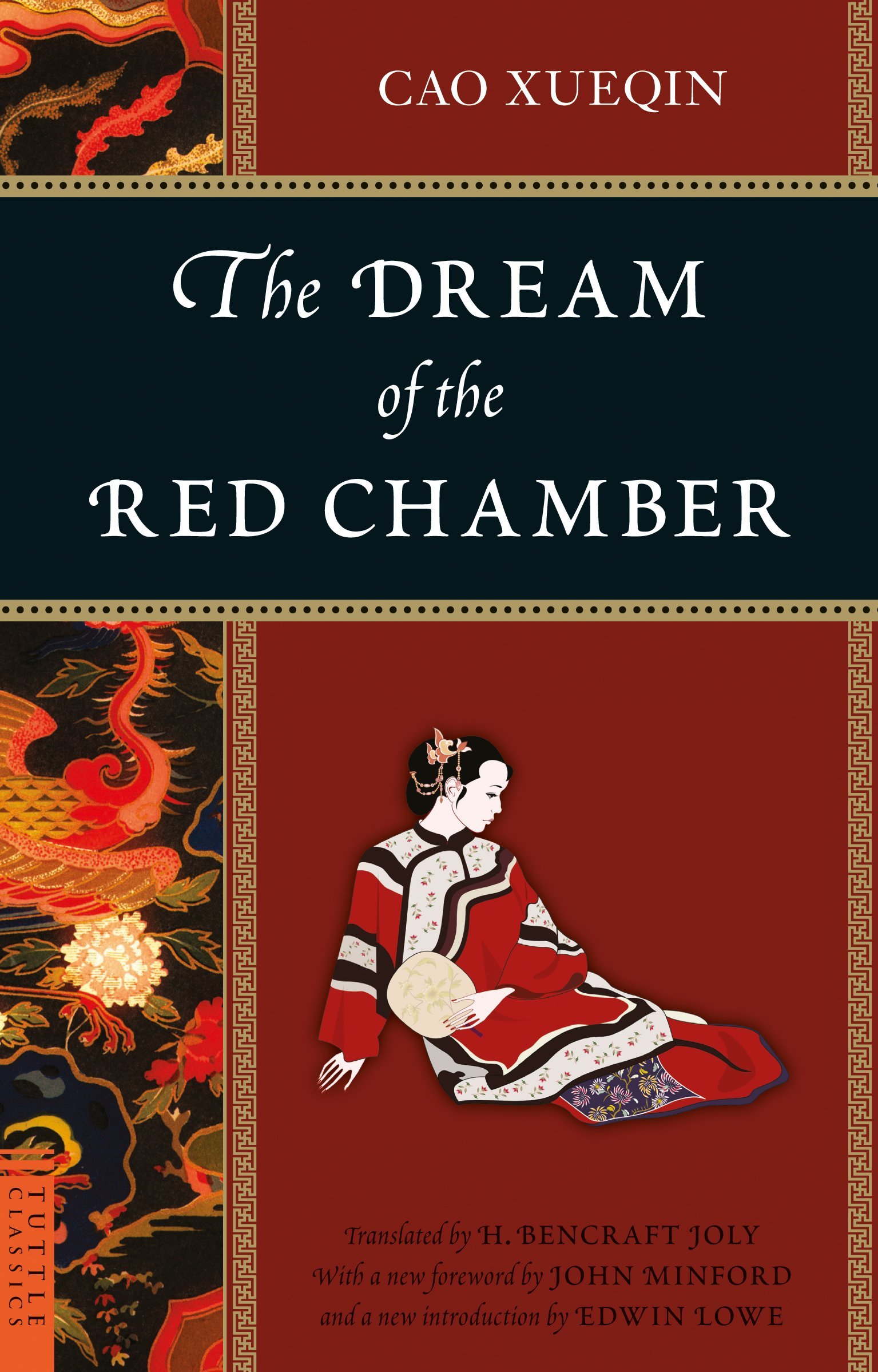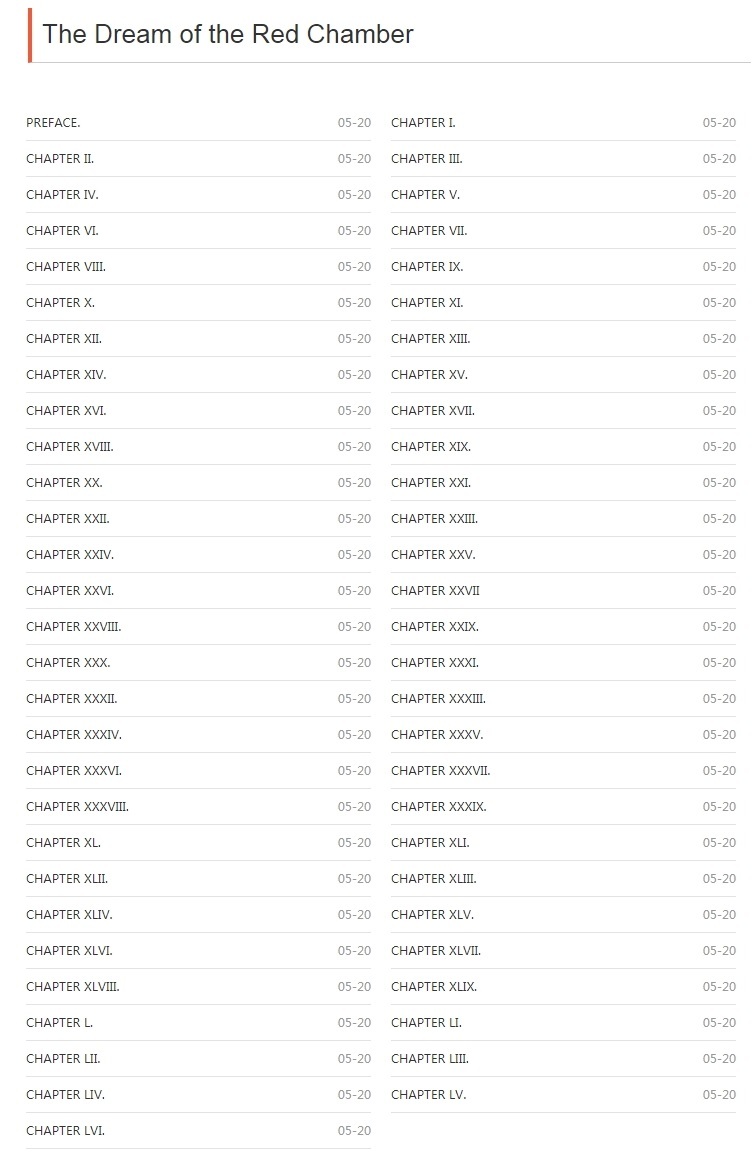

<< 滑动查看下一张图片 >>
目录

世界村·数字图书馆
官网:Book.yuyang.org
扫二维码下载电子书

★ 资源下载 ★
01 | 红楼梦 |
01 | The Dream of the Red Chamber |
内容简介
The Dream of the Red Chamber is one of the "Four Great Classical Novels of Chinese Literature." It is renowned for its huge scope, large cast of characters and telling observations on the life and social structures of 18th century China and is considered by many to be the pinnacle of the classical Chinese novel.
The "Red Chamber" is an expression used for the sheltered area where the daughters of wealthy Chinese families lived. Believed to be based on the author's own life and intended as a memorial to the women that he knew in his youth, The Dream of the Red Chamber is a multilayered story that offers up key insights into Chinese culture.
作者简介
Cao Xueqin was born into a wealthy family whose status and fortune diminished when he was a child. He spent the remainder of his life in poverty. The Dream of the Red Chamber, which he devoted ten years of his life to write, was not published until thirty years after his death.
H. Bencraft Joly was Vice-Consulate of Macao at the time he translated The Dream of the Red Chamber in an effort to advance appreciation of Chinese literature among Western scholars.
编辑推荐
Reviewer: Melvin Pena (Evanston, IL United States)
I spend a lot of time wandering through bookstores. One particular book has caught my eye over the years, and the other day I bought it - Volume 1 of Cao Xueqin's eighteenth century epic, "The Story of the Stone: The Golden Days". As a developing eighteenth century scholar, I was doubly attracted to it. "The Golden Days" absolutely blew me away - used as I am to eighteenth century novels (British, French, American), this is wholly unlike anything I've read from the era. It bears structural similarities to the Laurence Sterne's "Tristram Shandy" and "Sentimental Journey," but aside from that bears more in common with ancient Greek novels like Longus's "Daphnis and Chloe" or Heliodorus's "Eithopian Romance," as well as the mysticism of the ancient Egyptian "Story of the Shipwrecked Sailor." And yet, Cao's attention to actual life experiences, and the detail he conveys about tradition and ceremony, along with frank dealings with human relationships and sexuality makes "The Golden Days" much more than any quick summary of style or content can relate.
"The Golden Days" begins in amusing, but sympathetic fashion: the goddess Nü-wa is repairing the sky with 36,501 stones. When she finishes, one remains, which is cast off. Having been touched by a goddess, this stone has magical properties, able to move, change size, and even talk. One day, a Buddhist monk and a Taoist come upon the stone, and promise to let the stone have an adventure - to become human. As the stone waits by a pond, it falls desperately in love with a Crimson Pearl Flower, which is also selected for incarnation by the Fairy Disenchantment. The stone and the flower are incarnated as the novel begins in earnest, as a young minor nobleman named Jia Bao-yu, and a commoner related to the family, a girl named Lin Dai-yu - both unaware of their heavenly origins. "The Golden Days" centers around the daily events and occurrences in the lives of these two teenagers, as they come to grips, as we all must, with human life.
The Rong and Ning branches of the Jia family, on opposite sides of Two Dukes Street, are the centerpieces of the novel's action. Like the "big house" fiction of the English eighteenth century, these ancestral manses provide a locus of activity, as the nobles, their extended families, friends, and servants mingle and interact constantly. Cao marks himself as a remarkable author by the way he handles a massive cast of characters, letting us into the private lives and concerns of all ranks of society, as well as the forms of etiquette that determine their relationships. Another terrific facet of the novel's construction is the almost stream of consciousness style Cao employs - as characters pass in and out of the immediate action of the novel, the narrative seems to choose the person it's most interested in and follow them for pages at a time, before seamlessly passing to the next character. It's really quite amazing, how, in this way, we come to understand the motivations, fears, and hopes of so many individuals. Time, distance, culture, Cao levels distinctions, making historical China accessible to even 21st century readers - he reduces people to their human concerns.
Cao Xueqin's novel is also remarkable for what I can only call it's pro(to)-feminist tone. While we are reminded by certain characters that male lineage is of major importance to the structure of the society, the narrative consistently shows the power, ability, and influence of women. At the novel's beginning, a Taoist named Vanitas finds the stone, and is asked to transcribe its story, but complains initially that it is about a "number of females". The stone obviously insists that the story be written out. Later, Bao-yu, the major male character, says he is more comfortable around women - that they are like water, while men are like mud, castoffs, unclean. One of the main characters of this volume is Wang Xi-feng, a young woman in her early twenties, who for an extended period, manages the affairs of both the Ning and Rong mansions. Cao's respect and admiration for the strong women in Bao-yu's life: Xi-feng, Dai-yu, and two particular servants, Aroma and Caltrop, is quite obvious and important to the novel.
If you are like me, and know tragically little about Chinese literature and culture, Cao takes care of that too - there is a heavy emphasis throughout the novel on the cultural productions of China. The book integrates a wide range of poetry, drama, fiction, folk wisdom, and mythology as a central part of Bao-yu and Dai-yu's upbringing. One can sense Cao's insistence in the novel that education and cultural production is of vital importance, particularly to children. While the Fairy Disenchantment seems to be the guiding spirit of the novel, hinting at the diappointments inevitable in the course of life, this is a novel about youth, and hope for the future, even in the midst of concern about how long prosperity can last. Taken altogether, "The Golden Days" cannot be recommended enough. David Hawkes's translation is first rate, and his introduction, pronunciation notes, and appendices are thorough and very helpful.
Reviewer: Matthew M. Yau "Voracious reader" (San Francisco, CA)
The Dream of the Red Chamber (The Story of the Stone) starts off as an immensely long inscription on a miraculous stone which was copied out by a visiting man and taken down into the world for publication. Volume 1 gives the account of the magic stone's origin, renders the discourse redolent of a supernatural, mystical overtone. Once upon a time a piece of stone that was unworthy to be used for repairing the sky possessed magic power and ended up in the mortal world. The unhappy stone incarnated and lived out the life of a man before finally attaining nirvana and returning to what Buddhist refers as the "other shore."
Jai Baoyu is the incarnation of the stone. The name "bao-yu" means "treasured jewel" and was named after the wonderful incident that the only surviving son of the Jia household was born with a piece of spotless jade in his mouth. Lin Daiyu, Baoyu's teary cousin with a superior intelligence, is the incarnation of the Crimson Pearl Flower, which the unhappy stone once conceived a fancy that he took to watering everyday so the flower was able to shed the form of a plant and became a girl. The consciousness that she owed the stone ensued her to repay him with the tears shed during the whole of a mortal lifetime if they were ever to be reborn as humans in the world beneath. It was no wonder when Daiyu first saw her cousin, who had tyrannized the household, hated studies, and spent most of his time in women's quarters, it was as though she had seen him somewhere before, like a déjà vu.
Aside from the ethereal origin, the first volume of The Dream of the Red Chamber depicts a fairly eventual record of a great Manchu household (Qing Dynasty) under the tutelage of the Imperial family in early 18th century China. It's the picture of daily routines in the life that emerge most vividly from its discourse. The Jia household is genuinely disguised as some highborn aristocrats whose ancestors were ennobled for their military powers. This first installment of five parts, titled Golden Days, captures the Jias at the hi-time in which members of the Rong-guo mansion and the Ning-guo mansion dressed in silk, ate delicately, pampered by a domestic hierarchy of servants and maids, when they were still nested in the protecting shadow of the ancestors and the readily accessible wealth. The family's decline and fall constitute the general background of the novel.
With over 500 characters, thousands of one-hit appearances and a skein of household members and their distant relations of the clan, reading of The Dream of the Red Chamber will be more pleasurable and rewarding with the family genealogy handy. The book has a general flow of daily happenings and inter-family drama, with an emphasis on the relationship between Jia Baoyu and Lin Daiyu. Household activities, domestic anecdotes, subbing rivalries, seditious schemes, love affairs, contention between concubines, political intrigues, black magic, witchcraft, and even murder constitute to the pages of this Chinese epic that evokes Remembrance of Things Past and One Hundred Years of Solitude. The heart of the novel is the pre-destined relationship between a semi-ethereal entity and magic stone under the context of the Buddhist understanding that earthly existence is an illusion. This meeting, though is meant to be, is in vain, one that is full of tears.
When the fairy led Baoyu into the land of illusion and showed him his fate, he could scarcely make out of what he saw. Nature might have endowed him an eccentric obtuseness of a simpleton. How does one expect a 13-year-old (scholars deem him to be 13 throughout most of the book) to recognize and seize his destiny? The fairy showed him not only his life cycle but also the romantic passions, love debts, heartbreaks of dust-stained human world. Baoyu was destined to mingle with girls around him. The ancestors thought Baoyu had inherited a perverse, intractable nature that rendered him eccentric and emotionally unstable. Exposure to the worldly illusions of decay might hopefully succeed in enlightening, awakening, and transforming him.
Daiyu seems to know Baoyu more thoroughly than anyone does. She is able to nail his problem despite her occasional tiff with him over trivial matters. Baoyu always complained about people's getting angry with whatever he did, but he never realized how much he had provoked them at the first place. Couplets, poems, and verses in the novel hint at his friendlessness in the mortal world and the incessant debate over the depth of his relation with Daiyu. The roaming back and forth, sink and soar between sorrow and elation between the two incarnated cousins constitute to the understanding that earthly existence is indeed a transience but karma determines the shape of one's life and the life after. This idea of life being a dream from which one eventually awakes is a Buddhist tenet, but the incorporation of it into the novel becomes a poetic gesture to demonstrate that the main character (Baoyu) is indicative to the author.
The Dream of the Red Chamber in Chinese has the connotation of being rich and grand. The title can refer to a dream of the vanished splendor and opulence. The frequent use of dream imagery implies the possibility that the luxurious world of the author's youth, which he attempted to reconstruct, had vanished so utterly at the time of writing. The story of the Jias closely accorded with fortunes of Cao's own family, which attained its height under the reign of Kangxi. But the exact relationship existing between characters of the novel and members of Cao family is uncertain and discreet. Baoyu is assured to be author's self-portrait, whose struggle towards emotional maturity was delineated with an affluence of nuance. Other characters could be compsite of several family members over different generations for the purpose of disguising facts.